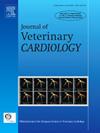Idiopathic spontaneous intracardiac microbubbles in an adult dog
IF 1.3
2区 农林科学
Q2 VETERINARY SCIENCES
引用次数: 0
Abstract
A four-year-old, female neutered English springer spaniel presented for evaluation of exercise intolerance, panting and lingual cyanosis. Echocardiography revealed a structurally and functionally normal heart with the presence of spontaneous intracardiac microbubbles entering the right side of the heart from the caudal vena cava. A cause for the clinical signs could not be identified; routine blood work, urinalysis and electrocardiography were unremarkable. Testing for tick-borne diseases, clotting times, cardiac biomarkers, thyroid function and basal cortisol were all within normal limits. Faecal samples tested for Clostridium perfringens alpha, beta and epsilon toxins were negative. Genetic conditions including malignant hyperthermia and phosphofructokinase deficiency were excluded. Computed tomography and angiography of the abdomen and thorax revealed no abnormalities or shunting vessels that could explain the origin of the spontaneous intracardiac microbubbles. Previously, microbubbles have only been visualised when intravenous access is present or when purposeful contrast studies are performed. As far as the authors are aware, this is the first case of spontaneous intracardiac microbubbles visualised in the right heart of a dog with no identifiable underlying systemic conditions.
成年犬的特发性自发性心内微泡
一只四岁,雌性绝育的英国施普林格西班牙猎犬提出评估运动不耐受,喘气和舌紫。超声心动图显示心脏结构和功能正常,存在从尾腔静脉进入心脏右侧的自发心内微泡。临床症状的原因无法确定;血常规、尿常规、心电图无明显异常。蜱传疾病、凝血时间、心脏生物标志物、甲状腺功能和基础皮质醇的检测均在正常范围内。粪便样本的产气荚膜梭菌α、β和epsilon毒素检测均为阴性。排除了包括恶性高热和磷酸果糖激酶缺乏在内的遗传条件。腹部和胸部的计算机断层扫描和血管造影显示没有异常或分流血管可以解释自发性心内微泡的起源。以前,微泡仅在静脉注射或有目的的对比研究时可见。据作者所知,这是第一例在没有可识别的潜在系统疾病的狗的右心出现自发性心内微泡的病例。
本文章由计算机程序翻译,如有差异,请以英文原文为准。
求助全文
约1分钟内获得全文
求助全文
来源期刊

Journal of Veterinary Cardiology
VETERINARY SCIENCES-
CiteScore
2.50
自引率
25.00%
发文量
66
审稿时长
154 days
期刊介绍:
The mission of the Journal of Veterinary Cardiology is to publish peer-reviewed reports of the highest quality that promote greater understanding of cardiovascular disease, and enhance the health and well being of animals and humans. The Journal of Veterinary Cardiology publishes original contributions involving research and clinical practice that include prospective and retrospective studies, clinical trials, epidemiology, observational studies, and advances in applied and basic research.
The Journal invites submission of original manuscripts. Specific content areas of interest include heart failure, arrhythmias, congenital heart disease, cardiovascular medicine, surgery, hypertension, health outcomes research, diagnostic imaging, interventional techniques, genetics, molecular cardiology, and cardiovascular pathology, pharmacology, and toxicology.
 求助内容:
求助内容: 应助结果提醒方式:
应助结果提醒方式:


